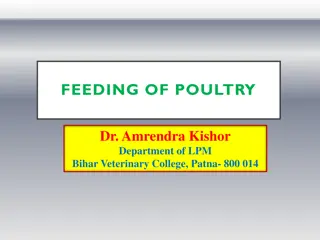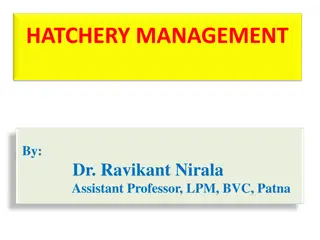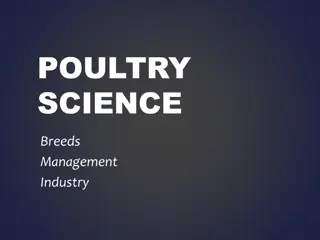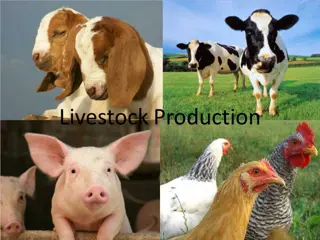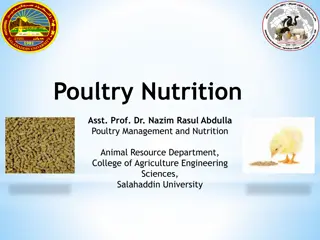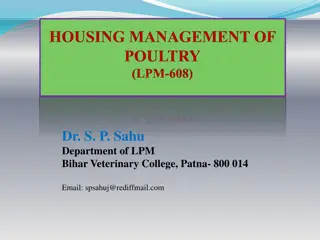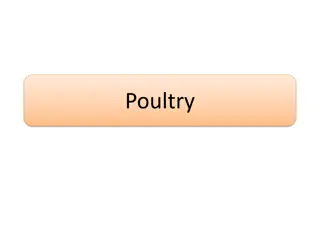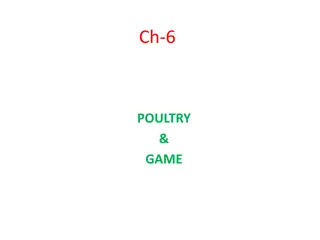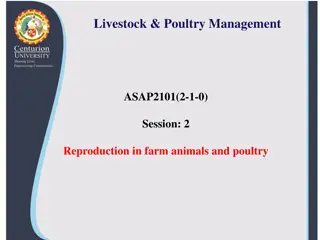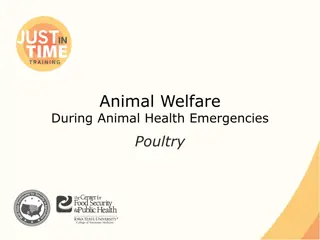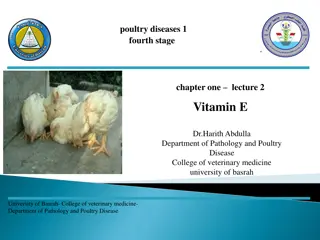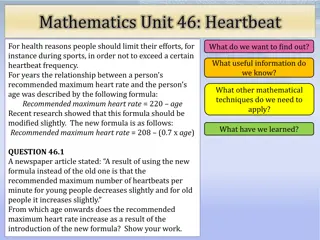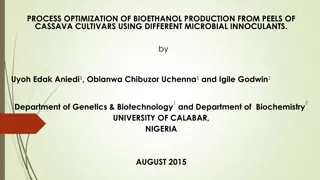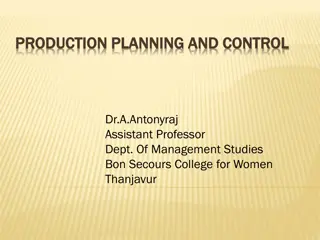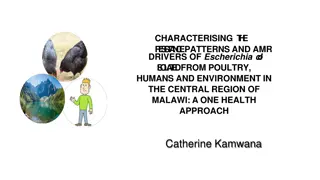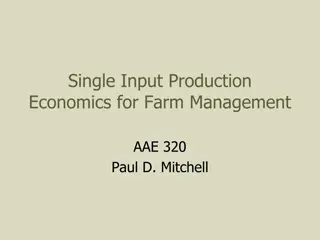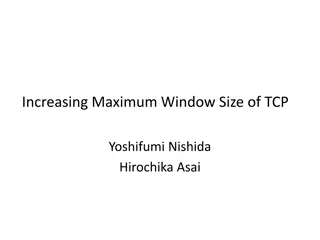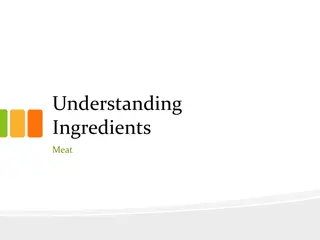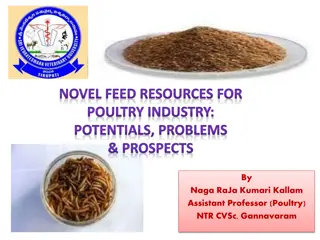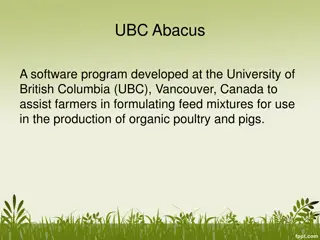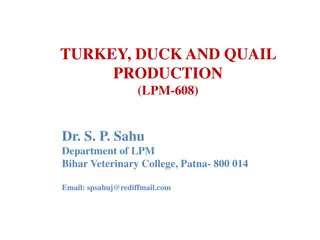Effective Poultry Management Practices for Maximum Production Efficiency
Poultry management involves various practices like brooding, ventilation, sanitation, and hygiene to ensure the wellbeing of birds and maximize production efficiency. Implementing scientific methods and personal experience are key to successful poultry management. Specific care needs to be taken during critical periods like brooding chicks. Adequate ventilation, cleanliness, and proper space allocation are crucial in broiler farming throughout the year.
Download Presentation

Please find below an Image/Link to download the presentation.
The content on the website is provided AS IS for your information and personal use only. It may not be sold, licensed, or shared on other websites without obtaining consent from the author. Download presentation by click this link. If you encounter any issues during the download, it is possible that the publisher has removed the file from their server.
E N D
Presentation Transcript
Dr. S. P. Sahu Department of LPM Bihar Veterinary College, Patna- 800 014 Email: spsahuj@rediffmail.com
POULTRY MANAGEMENT Husbandry practices to maximize the efficiency of production by satisfying the basic needs of the birds. Management practices for commercial broilers and layers: Entirely different. Management practices for breeder broilers and layers: Same as the ultimate objective is to maximize baby chicks production.
Successful poultry management depends on: Judicious implementation of scientific practices Personal discretion Personal experience
BROODING MANAGEMENT OF CHICKS Chicks transferred to brooder house just after hatching and reared there for 6-8 weeks. Most critical period of life of birds. Best time to procure replacement stock or starting of layer farm: January-April (hens are in high production during winter months fetching higher prices).
Broiler farm: Started any time of the year as it is a continuous process. Comfort of chicks in brooder house depends on ventilation, sanitation and hygiene, litter, temperature, brooder space, brooder guard, floor space, water space and feeder space.
Ventilation: Adequately ventilated and free from draft. For removal of Co2, heat, healthy environment, dryness in brooder. Avoid too dusty environment which irritates the respiratory tract and transmits diseases. Optimum Co2 concentration: 0.3-0.5%.
Ventilation . At 1% concentration of Co2: increased mortality. 5% Co2: completely lethal O2 concentration: Not less than 21%. Avoid too much moisture causing ammonia fumes which irritating the respiratory tract and eyes.
Sanitation and Hygiene: Brooder house properly cleaned and disinfected with disinfectant solution before placing the chicks. All movable equipments (feeders, waterers, hovers): cleaned and disinfected. Litter: scraped and removed. Interior and exterior of brooder house: cleaned under pressure.
Sanitation and Hygiene Malathion spray/blow lamp: to control ticks and mites. Insecticides: mixed with litter at recommended doses. Adopt all in all out system to control and prevent diseases. Restrict the movement of workers and equipments. Foot bath at entrance of each building.
Litter: Suitable litter materials like sawdust, paddy husk, chaffed paddy straw, shredded papers etc. locally available. Thickness: 5 cm at the starting and increased upto 7-10 cm in course of time by gradual addition. Never use mouldy litter materials. Litter stirred at frequent intervals to prevent caking.
Litter . Wet litter must be replaced by dry litter immediately to prevent ammoniacal odour. Moisture content of litter: 20-25% Low moisture: dustiness High moisture: hot and caked litter, high ammonia production.
Temperature: Maintain right temperature in brooder house. Too high and low temperature: Slow growth and high mortality.. Temp. recording: 5 cm above the floor and 5-7.5 cm inside the edge of warm portion of the brooder.
Temperature During first week, start with 95oF which is reduced 5oF per week during successive weeks till it reaches to 70oF. Brooders: switched on atleast 24 hours before chicks arrival. Temperature under brooder house: 10oC below the brooder temperature. Control temp. by using max.-min. thermometer.
Chicks behaviour: Getting desired amount of heat. Less temp.: close to heat source and huddling. High temp.: away from heat source and panting/gasping. Optimum temp.: evenly scattered. Hover type electric brooder: thermostatic control.
Minimum clearance space of 12-15 cm above the chicks is recommended in hover brooder. More hover height: excessively heating and high fuel cost. Electric bulbs: temp. control is difficult but not impossible. Infra-red lamp: very good for brooding
Brooder Space: 45-65 sq. cm per chick. Hover with 1.8 m diameter: 500 chicks. Avoid overcrowding as it results into starve-out, culls and increase in disease problems.
Brooder Guard: To prevent straying of baby chicks from heat source and to prevent floor drafts. Placed 0.9-1.2 m away from the edge of hover. This distance is increased slowly each day to a max. of 1.5 m. Not required after 7-14 days.
Floor Space: At start: 0.05 sq. m per chick and increased by 0.15 sq. m every 4 weeks till pullets are of 20 weeks age. Female broiler: 0.1 sq. m. Male broiler: 0.15 sq. m. till 8 weeks of age. Rear broiler pullets and cockerels in separate pens. Avoid overcrowding: Uneven and poor growth, high incidence of cannibalism and diseases
Water Space: Plenty of clean and fresh water. 50 linear cm per 100 chicks for first 2 weeks. 100-150 cm: 3-12 weeks. 250 cm: after 12 weeks of age. Water should be provided through fountain initially.
Water Space By trough: 2.5 cm above the height of the chicks to reduce spillage. Add antibiotics and stress medication whenever needed. All waterers cleaned daily. teach new chicks to drink water by holding a few chicks at a time. Provide sugared and electrolyted water after 12-48 hours of hatch.
Feeder Space: 0-8 weeks: 2.50-6.75 cm per bird. Chicks should be fed 3-4 hours after arrival at the brooder house. Chick feed: spread on papers for few days. Feeder should be filled one-third only at any time to avoid feed waste.
Feeder Space .. Feeders and waterers: arranged around the hover like spoke of a wheel to offer all chicks equal opportunity of warmth, feed and water. Layers: uniform distribution of night-light upto 8 weeks of age. Broilers: all nigh dim light for max. feed intake. For max. wt. gain: intermittent light as 1 hr light- 3 hrs darkness or 2 hrs light- 2 hrs darkness.
GROWER MANAGEMENT Pullet quality: Important for optimum exploitation of genetic potential of layers. Prime objective of growing programme: Produce pullets which start laying around 20 weeks of age with av. B. Wt. of 1.2-1.4 kg. At same age: Male broiler parents : 2.5 kg Female broiler parents: 2.0 kg.
Floor space: 800-1000 cm2 /bird Feeder space: 6.5-10.0 linear cm. Waterer space: 1.5-2.5 cm Water consumption depends on Temp., Humidity, Age, Dietary Constituents, Activity and Air movement.
Water consumption increases rapidly when temp. exceeds above 30oC/85oF. Deworming: Once bimonthly to reduce parasitic diseases: Evening or Early Morning. Top 0.5 cm of litter is scraped and removed to prevent reinfection. Lighting schedule: decreasing till 20 weeks age. Debeaking: between 12-16 weeks of age.
Feed restriction for broiler breeders to control B. Wt. and maturity otherwise results in higher feed cost, lower egg production and hatchability. B. Wt.: Recorded weekly/fortnightly for uniformity of birds and regulating feeding programme.
Feed grower ration: 15% CP, 2600 calorie ME and 5-10% fibre with proper vitamins and minerals. Grower feeds: contains Coccidiostat for development of immunity against coccidiosis. Culling of underdeveloped, diseased type of undesirable pullets as early as possible.
LAYER MANAGEMENT Transfer pullets to layer house at 18-20 weeks of age a/c to size and growth. Floor space: 1800-2000 cm2/bird in DLS. Feeder space: 14 cm/bird in DLS. Waterer space: 2.5 cm/bird in Deep Litter syst. Floor space: 450-600 cm2 in cage system
Lighting: from 21 weeks gradually increase till it reaches to 16-17 hours/day. Correct lighting boosts up egg production by 5-10%. Irregular light drops in egg production. Correct light: 1 foot candle/bird at eye level (one 40 watt bulb with reflector hung at 2.1 m above the floor for each 9 m2 of floor space).
Breeder males: Provided diet with extra calcium, mangnese and vit. E for proper fertility. Males & females reared separately to increase uniformity, reduce culling, even growth and better production.
Age (weeks) Light (hours) Light intensity Light intensity (lux) (foot candles) 1 to 3 3 - 20 20 - 21 21 - 22 22 - 23 23 - 60 24 hrs- 8 hrs 20 8 11 13 14 15 2.0 0.5-1.0 4.0-6.0 4.0-6.0 4.0-6.0 4.0-6.0 5 - 10 40 - 60 40 - 60 40 - 60 40 - 60
Stress: Vaccination, medication, disease outbreak, improper and restricted feeding, weather inclement, starvation, dehydration and shifting of birds Checked supplementation. by antibiotics, vitamins, minerals
Housing: Open-sided poultry houses, well ventilated, cool in summer and hot in winter and free from drafts. Long axis of shed: East-West direction in hotter areas and facing north to south. Distance between 2 houses: 20 m for proper ventilation. Young stock sheds should be 50-100 m away from adult stock to prevent disease transmission. Width of open sided house: max. 9 m for proper ventilation.
Poultry houses: Cheap, durable, comfortable and safe. Floor: Moisture proof, free from cracks, easily cleanable and rat proof. Walls & partitions: solid enough to support the roof and withstand heavy winds. Moisture and draft proof Insulation of roof to maintain temperature during winter and summer.
Roof painted with aluminium white to reduce room temperature by reflection. Overhangs: 1m to check rain water. In open-sided house: 2/3 of area of wall remains open and fitted with wire mesh for proper ventilation.
Poultry houses: located on well drained ground, safe from flood and easy access to road. Height of poultry shed: 2.6-3.3 meter from the foundation to roof line. Optimum temperature of layer house: 55-75oF.
Feeding: actual feed consumption depends on Body weight of hen Rate of egg production Season and weather condition Health and physical condition of hen Feed quality in terms of protein and energy content.
Feed intake increases as the pullets/hens increases their egg production. Feed should be uniformly distributed so that all hens get their share easily. One feeder for shell grit/oyster shell for every 250 pullets @1.5kg per 100 birds/week from 22nd weeks of age. Hen needs less feed in summer and more feed in winter. During extreme hot months, stimulate feed intake by changing ration containing higher protein and other nutrients.
Weak, non-layers and poor layers should be culled regularly. Eggs -- collected 3 to 4 times daily. During storage, temperature should be 50-55oF and relative humidity 75-80 per cent. Birds should be protected from extreme hot and cold climate.
Proper hygienic condition should be maintained in the shed. If there is problem of ticks and lice, then dusting or spraying should be done to control the external parasites. Clean and fresh water should be provided daily. Height of feeder should be adjusted according to the height of birds.
SELECTION IN POULTRY Selection is the process of selecting the best to be the parents of the next generation. There are two methods. 1. Individual or mass selection: It is based on the performance of an individual bird. It is very effective system of improvement of traits which are highly heritable and expressed in both the sexes. 2. Family selection: In family selection, the entire group of individuals is either selected or rejected as a whole, based on mean performance of individuals in the group. It is practiced for traits of low heritability and has two phases.
Progeny testing: Progeny testing attempts to evaluate animals on the basis of performance of their progenies. Sib Testing: To overcome the problem of time consuming in progeny testing, breeders largely use sib testing. First, selection based on mean performance of sibs kept in groups of unrelated individuals. Second, selection based on mean performance of sibs kept in family groups. The most successful breeding programme will include the combination of individual selection and family selection.
METHODS OF MATING Flock mating: A number of males and females are bred together. Pedigree records are not maintained. Pen mating: One male is bred with a number of females. Pedigree records are maintained by use of trapnests. Artificial insemination: For the birds housed in a cage.
CULLING OF POULTRY Culling is a procedure to separate uneconomical and diseased birds from the layer flock. Natural phenomenon that there will some birds, which will not grow well and ultimately will become poor layers and uneconomic. Culling should be done during night hour to avoid undue stress on birds due to excitement and handling.
1. Condition of bird: It includes health of the bird such as tight feathering with tail and wing feather, bright expression and alertness. Lack of condition is exhibited by the appearance of comb and eye. Birds showing pale and shrunken comb, emaciated face, thin breast, drooping wings and tail feathers should be culled.
Characteristics of good and poor layers Character Good layer Poor layer Head and nature Strong, Square and broad at the top. All parts well- proportionate. Feminine in female and Masculine in male Coarse, crow headed, narrow, tendency to masculine in female and feminine in male Comb and wattle Beak Full, red, waxy and warm Short and solid well curved Dry, scaly and cold Narrow, very long, thin sharp and pointed. Shrunken, wrinkled, off colour than breed. Dull, sleepy Yellow Long and thin Limited capacity, Narrow not Straight Shallow, Barrel shaped Closer to each other, thick and Stiff, distance in between loss than 2-3 fingers. Less than 2-3 fingers. Earlobes Full, waxy, colour as per breed specification Bright, alert and well set Bleached, thin and flat Bleached Stocky and rather short Capacious, broad and straight Deep and straight Wide apart, thin soft and pliable Distance in between more than 2-3 fingers. More than 4-5 fingers Eye Ear lobes Neck Body Back Pubic bone Distance keel and pubic bones between
Character Good layer Poor layer Skin Thin, Soft, oily and silky Thick, dry rough and under laid with fat. Abdomen Vent (for females) Plumage Large, soft and moist. Free from fat Large, oval and moist Tight, compact colour specific for breed Small, hard and fat deposits Small dry and round Loose, scattered off colour from breed Legs Shank Toe nails Temperament Appetite Thin, soft and curved at back Dry, old bristle, soiled Stocky well curved Friendly and always happy Heavy eater and crop always nearly full Thick, hard and rounded at back yellowish, round, full Long, thin and sharp pointed Shy, nervous frighten when caught Poor eater, crop is near to empty Pigmentation Pigment disappears from beak skin, vent shank and wings as laying advance and they will appear faint in colour Pigmented beak, skin and wings are brightly coloured. Vent Time of moulting Bleached, large oval and moist Late and quick Yellow round small Early and slow
2. Moulting patterns: Moulting is a natural physiological process to shed old feathers with new feathers at the end of first year of laying. Early moulters (Before 72 weeks of age) are usually poor layers. Such birds start moulting at early age and take unusual long time (24 weeks time) to complete moulting. Often these birds stop laying during moulting periods. They shed only on primary feathers, complete the moulting quickly by shedding two or more primary feathers together and complete the moulting with 4-8 weeks period.
3. Depigmentation: There is abundance of yellow pigments in the different parts of body of pullets. This is due to the deposition of carotenoid pigment mainly xanthophyll which comes from feed. As the pullets come in egg production, these pigments are transferred from body to eggs. The depigmentation in good layer follows a particular pattern depending upon the blood circulation. The order in which it disappears first from vent eye ring- ear lobes- beak (beginning at the base and extends towards tip)- shank (first at the front and then at rear side).
4. Sexual Maturity: The duration between the date a pullet hatched and the date she lays first egg. Good layers mature earlier within 18-20 weeks. The birds which mature after 22 weeks should be culled out.


